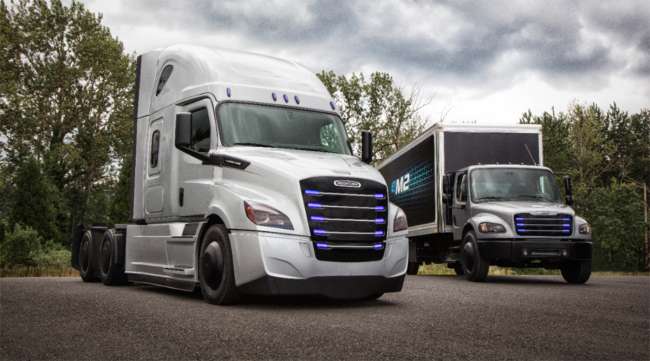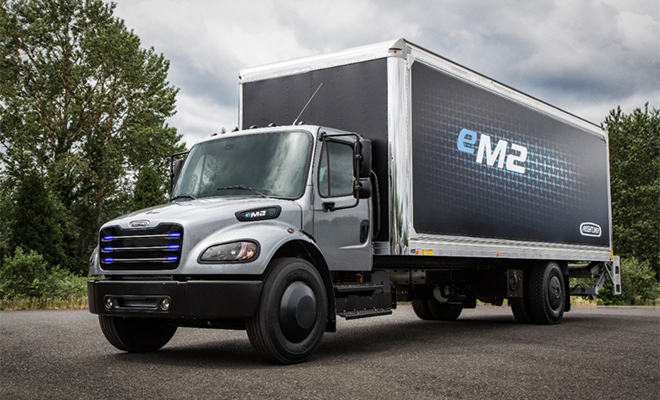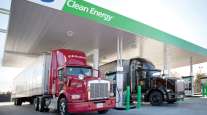Managing Editor, Features and Multimedia
Freightliner Unveils All-Electric eCascadia, eM2 Models

PORTLAND, Ore. — Freightliner Trucks has unveiled all-electric versions of its flagship heavy-duty Cascadia and medium-duty M2 models, marking a major step toward its goal of offering a broad lineup of electric trucks in the North American market.
The first-generation eCascadia and eM2 trucks made their public debut here June 6 at the Portland International Raceway during Freightliner parent company Daimler Trucks’ Capital Market and Technology Day.
With these new models, Daimler has presented electric trucks not as niche products, but as an integral part of the future of commercial vehicle technology.
NEW RESEARCH FACILITY: Portland home to new automation center
'IT'S UP TO THE SHAREHOLDERS:' Daum lukewarm on splitting into separate car/truck companies
Daimler Trucks North America CEO Roger Nielsen said the company is preparing to pivot its operations “to bring e-mobility into the realm of our core businesses.”
“We are all in for tackling the electrification challenge for North America,” he added.
The truck maker intends to begin series production of the eCascadia and eM2 in 2021.
But first, Freightliner plans to deliver about 30 of these battery-electric trucks to U.S. fleet customers later this year to further test the vehicles in real-world operations.
This Freightliner “electric innovation fleet” will help the manufacturer expand its knowledge of how electric vehicles will work in trucking, Nielsen said. “We have much to learn, but we are well on our way.”
Daimler’s goal is to offer electric trucks that not only eliminate emissions, but also enhance fleets’ bottom lines through lower operating costs.
Martin Daum, the head of Daimler’s global truck and bus business, said the company is determined to extend its status as the largest manufacturer of commercial vehicles into the emerging electric-truck segment.
.@DaimlerTrucksNA CEO Roger Nielsen greets global truck and bus CEO Martin Daum after arriving in electric school bus. pic.twitter.com/dFbGPCLT64 — Seth Clevenger (@SethClevenger) June 6, 2018
“We have a clear mission. We want to become the undisputed, global No. 1 when it comes to e-mobility, as we are when it comes to combustion engines,” said Daum, who arrived at the presentation riding in a Fuso eCanter model, an electric Class 4 cabover that already is in production.
Now, with the eCascadia, Freightliner has created a battery-electric sibling for the top-selling Class 8 model in North America.
The version of the eCascadia showcased at the event was configured with electric motors at the axle ends that provide 730 peak horsepower. The truck, which has a maximum range of up to 250 miles on a single charge, is designed for local and regional distribution and drayage operations. The vehicle can charge up to 80% in about 90 minutes, the company said.
The eM2, meanwhile, offers 480 peak horsepower, a range of up to 230 miles and can charge to 80% in about 60 minutes, DTNA said, adding that the vehicle is well suited to local distribution, pickup and delivery, food and beverage and final-mile delivery.
Freightliner’s electric powered eCascadia makes its public debut in Portland. @DaimlerTrucksNA CEO Roger Nielsen says the truck will have a 250-mile range. pic.twitter.com/bQjbwnZ06I — Seth Clevenger (@SethClevenger) June 6, 2018
During the premiere of the eCascadia and eM2, Nielsen asked the event production crew to cut the music as the trucks drove into view to highlight how quietly the electric vehicles run compared with typical diesel trucks.
DTNA did not state prices for the vehicles.
The company will manufacture the eCascadia at its plant in Cleveland, N.C., and will build the eM2 at its nearby facility in Mount Holly, N.C.
DTNA’s new electric truck models also up the ante in the broader race to bring electric-vehicle technology to the trucking industry.
Other major truck makers also are pursuing electrification. Most recently, Volvo Trucks introduced two all-electric models in Europe.
Electric carmaker Tesla Inc. also has entered the race with the unveiling of its Tesla Semi late last year. At that event, CEO Elon Musk said the company would begin producing its electric truck model in 2019.
But even as competition grows, questions remain.
Daimler’s Daum and Nielsen harbored no illusions that the introduction of electric trucks will be without challenges.
The move toward electric vehicles is predicated on the expectation that battery technology will continue to improve and costs will continue to decline.
Another challenge will be establishing the charging infrastructure necessary to operate the trucks across longer distances.

Daimler Trucks North America
Daum described this as a “chicken versus egg problem,” where it’s not yet clear if electric vehicle volumes will need to ramp up before the infrastructure will be built, or vice versa.
In the meantime, the ideal applications for electric will be ones where the vehicle returns to the same location every day, and ones where the routes are predictable.
“With electric, at the moment, you still have to choose your routes very carefully,” Daum said.
To support its move toward electric vehicles, Daimler Trucks also established a new business unit to consolidate its worldwide expertise on electric drive systems across all brands and divisions.
This E-Mobility Group will guide Daimler Trucks’ electric-vehicle strategy and develop a standard, global architecture for electric vehicles.
Under this structure, Daimler’s electric-vehicle operations around the world will join forces and learn from each other so “they don’t invent the wheel in every part of world on their own.”
Daum pointed to the eCascadia and eM2 as examples of that type of collaboration. Those trucks include a lot of technology from Europe and Japan, Daum said, but also build upon current North American truck models and rely on a passionate American engineering workforce.
“That is what makes Daimler strong,” he said. “Whenever we collaborate on a global scale, we are an unbeatable combination.”




